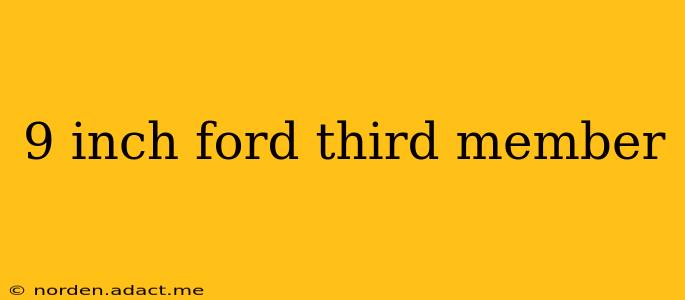The Ford 9-inch third member is legendary in the automotive world, renowned for its strength, durability, and massive aftermarket support. This iconic differential, originally designed for Ford's heavy-duty trucks and later found its way into Mustangs and other performance vehicles, remains a popular choice for custom builds and restorations alike. This comprehensive guide delves into everything you need to know about the 9-inch Ford third member, from its history to its various applications and modifications.
What is a Third Member?
Before we delve into the specifics of the Ford 9-inch, let's clarify what a third member is. Simply put, the third member is the housing that contains the differential gears and axles of a rear axle assembly. It's the heart of the rear-end, responsible for transferring power from the driveshaft to the wheels, allowing them to rotate at different speeds during turns. In the context of the Ford 9-inch, this robust housing is what makes it so desirable.
Why is the Ford 9-Inch So Popular?
The Ford 9-inch's enduring popularity stems from several key factors:
- Strength and Durability: Its robust design, featuring a large-diameter ring gear and heavy-duty construction, makes it incredibly durable, able to handle significant torque and horsepower.
- Massive Aftermarket Support: Decades of popularity have resulted in a vast aftermarket of parts and upgrades. Finding replacement parts, gear ratios, and performance upgrades is exceptionally easy.
- Versatility: The 9-inch can be adapted to fit a wide range of vehicles and applications, making it a versatile choice for custom projects.
- Upgradability: The sheer number of available upgrades means you can tailor the 9-inch to your specific needs, from mild street upgrades to all-out racing configurations.
What are the Different Types of 9-Inch Ford Third Members?
Not all 9-inch third members are created equal. Variations exist based on the year of manufacture, the vehicle it was originally installed in, and the specific gear ratios. These differences can affect the overall strength and capabilities of the unit. Understanding these variations is crucial when selecting a third member for your project. Factors to consider include:
- Housing Material: Early units might have cast iron housings, while later models may utilize nodular iron or even aluminum for weight reduction.
- Axle Shaft Size: The diameter of the axle shafts can vary, affecting the overall strength and capacity.
- Gear Ratio: Gear ratios can range from very low (high torque, low speed) to very high (high speed, low torque). Choosing the correct gear ratio depends on your vehicle's intended use.
What are Common 9-Inch Ford Third Member Modifications?
The aftermarket offers a vast array of modifications for the 9-inch, allowing enthusiasts to customize their performance characteristics. Common modifications include:
- Gear Ratio Changes: Swapping gear ratios to optimize performance for specific applications, such as drag racing or off-roading.
- Axle Upgrades: Replacing stock axles with stronger aftermarket units to handle increased power and torque.
- Locker Installation: Adding a locker to improve traction, particularly in off-road applications.
- Posi-Traction Units: Installing a limited-slip differential for improved traction on various surfaces.
How Do I Identify a 9-Inch Ford Third Member?
Identifying a 9-inch third member is relatively straightforward. The most prominent feature is the large 9-inch ring gear diameter. The housing itself typically features a distinctive shape and bolt pattern. However, always double-check the casting numbers for confirmation, as there can be minor variations.
Where Can I Find Parts and Information About the 9-Inch Ford Third Member?
Numerous online resources and automotive parts suppliers specialize in Ford 9-inch parts and information. Many forums and online communities dedicated to classic Ford vehicles and performance builds can provide expert advice and support.
This detailed exploration of the Ford 9-inch third member provides a comprehensive overview of this iconic differential. Remember, choosing the right 9-inch and the appropriate modifications depends heavily on your specific application and performance goals. Careful research and planning are key to ensuring a successful project.
